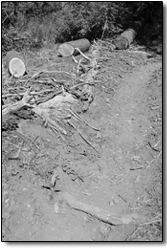|
|
||||
|
Big winter traumatizes trails Avalanches, lack of manpower hit San Juan forest hard SideStory: Status of San Juan singletrack
by Missy Votel As crews work to clear roads and trail users are once again gaining access to the high country, they are finding that the winter of 2004-05 packed a one-two punch. Not only did avalanche debris block many backcountry roads, but it has taken a toll on the San Juan National Forest’s trails as well. Specifically hard hit is the Columbine Ranger District, which encompasses the area north of Durango, including the nearly 500,000-acre Weminuche Wilderness. “We’ve got a problem in the high country,” said Richard Speegle, recreation project manager for the San Juan Public Lands Center. According to Speegle, the damage seen this year is the worst in decades. “This is a 30-year event,” he said. “Our biggest problem is avalanche slides and all the debris that came down with them.” He said the Forest Service is putting in a request for emergency federal funding, but in the meantime, trail users should be patient. “Wilderness rangers are just now getting into most places,” he said. “We’re trying to get to the trails one by one.” Lower-elevation trails near Durango, such as Dry Fork and those in Horse Gulch and the Mountain Park seem to have escaped the brunt of the winter’s wrath. However, trails at higher elevations have taken a beating, said Bill Manning, executive director of Trails 2000. “This year’s snowpack was extraordinary,” he said. “Mother Nature threw some avalanches beyond what we’ve seen in many decades.” Manning’s group recently completed work on its 15-mile adopted stretch of the Colorado Trail above Gudy’s Rest. Each year, a group of volunteers from Trails 2000 gathers for a weekend of work on the trail. While groups such as Trails 2000 adopt and perform maintenance on sections of the area’s more popular trails, including the Colorado, Dutch Creek, Jones and Pinkerton trails, the rest of the district must rely for the most part on Forest Service crews and rangers to clear the debris. Currently, the district’s only four-person trail crew is working in the Highway 550 corridor on trails such as Deer and Coal Creek. In addition to the crew, there are six wilderness rangers, who go out for four days at a time in pairs, as well as a crew from the Southwest Youth Corps, working in the Vallecito area. Nancy Berry, manager of trails and wilderness programs for the Columbine District, said once the forest’s trail crew finishes work on trails bordering 550, it will move east. The next priority will be the Lake Creek Trail, which accesses Emerald Lake, deep in the heart of the Weminuche, and then the Flint Creek Trail, which splinters off the Pine River Trail. Avalanche debris currently is blocking the Lake Creek Trail, including a spot half a mile south of Emerald Lake, as well as sections of the Flint Trail. “We’re going to work on Lake Creek next, hopefully by next week, and probably the next project after that will be Flint,” Berry said.
Complicating work is the fact that many of the trails needing work are in the nonmotorized wilderness area, meaning crews must travel on foot and no chainsaws are allowed. “It’s hard work,” he said. “We’re doing all the wilderness work with hand tools.” The goal is to make the trails passable now for people, and then to go back a second time to clear a wider path for pack animals, said Mark Winkworth, visitor information specialist with the San Juan Mountains Association. However, one trail that likely won’t4 open completely this summer is the Vallecito Creek Trail, which sustained heavy damage last winter including the destruction of the third bridge, about 6.5 miles in. “The biggie right now is the Vallecito Creek Trail,” said Winkworth. “A slide came down that whole valley, leaving a quarter mile path of avalanche debris. The third bridge is completely gone.” Winkworth said the Vallecito trail is important because it offers one of the few direct routes into the Weminuche and also hooks up with the Johnson Creek Trail, which accesses the Needle Range and Chicago Basin, home to the area’s Fourteeners. Unfortunately, with the bridge out, gaining access to Johnson Creek is extremely difficult if not impossible, and something Winkworth does not recommend. “I wouldn’t try crossing Vallecito Creek right now with the water so high, and I wouldn’t tell others to do it,” he said. Furthermore, with the bridge out, it’s hard to say if Johnson Creek is passable either, he added. Unfortunately, Berry said the Vallecito bridge will not be replaced this year due its remote location and the logistics involved. She said the Forest Service will likely rethink the bridge’s location, since it now is in the middle of a slide path and thus, could be taken out by subsequent slides. In the meantime, Winkworth said backpackers can use the Endlich Mesa or Needle trails, both to the west, to access Chicago Basin and the Fourteeners. With regards to snow, he noted that although conditions are changing rapidly, hikers should expect snow in the higher elevations, including the Highland Mary Lakes area and around Bolam Pass, near Purgatory. “North-facing slopes above 12,000 feet still could be covered, and the Fourteeners still have a lot of snow, which makes some of that scrambling dicey.” Nevertheless, he noted that for backcountry travelers on foot, most are obstacles surmountable, given some extra effort. “Just about anything’s doable right now, it’s just going to take some more time,” he said. “If you are on less-used trails, expect debris to slow you down.”
|



